 After years in Trans Am collaborating on sounds from the extremelyexperimental to the completely inane, Sebastian Thomson finally giveshis own songs a go with The Frequency, and the results are enough tosend my head reeling into eternal confused giddiness. Thomson plays themajority of the instruments himself as well as handling vocal duties,with guests here and there as necessary. This album was finally anexplanation to me for TA, as most of the songs have a new wave/Beat Streetsoundtrack vibe. That's not to say "Blame Seb for that piece of crap,"but instead to say that his desire to make an '80s club booty recordmay have driven that release and bleeds over to this one. At momentswhile listening to this debut, I felt I was listening to the long lostmusic of hitchhikers on the Autobahn, then I wanted to breakdance, thenlaugh out loud the shouts of "move dat ass! move dat ass!" followed bysynchronized thrashing a la Warrant. In the middle of it all, though,is a unique voice trying to get out, and for that and trying to shakesome posteriors Thomson deserves some props. The style-meter is allover the place for this band, and that's sometimes the problem as theswitch can jar uncomfortably. Nevertheless, there are real nuggets tobe found. "Erasing Myself" is an arena rock anthem of magnumproportions, destined for inclusion on some teen angst coming of agecompilation bust still cutting-edge enough that indie rock and hairmetal fans might blast it. The gutter bass, snare snazz, and space saxof "Allnite" may just be the solution to the boredom on manydancefloors, where "You're the Perfect Size" and "Moonburn" are hardrock intensity with vague sexual innuendo spread throughout — withextra panting on the latter. There's also near-death metal here andthere, like on "Tell Me" and "Forgot," and a touch of that familiarTrans Am sound on "Chicas." Thomson appears to wrestle with thedifferent sides of his personality much in the same way Trans Am does,but he's at least decided on a pop-song structure, which in and ofitself puts him ahead of the pack in the electro-rock genre. TheFrequency are on tour soon opening for Trans Am, so show up early for ataste of this live.
After years in Trans Am collaborating on sounds from the extremelyexperimental to the completely inane, Sebastian Thomson finally giveshis own songs a go with The Frequency, and the results are enough tosend my head reeling into eternal confused giddiness. Thomson plays themajority of the instruments himself as well as handling vocal duties,with guests here and there as necessary. This album was finally anexplanation to me for TA, as most of the songs have a new wave/Beat Streetsoundtrack vibe. That's not to say "Blame Seb for that piece of crap,"but instead to say that his desire to make an '80s club booty recordmay have driven that release and bleeds over to this one. At momentswhile listening to this debut, I felt I was listening to the long lostmusic of hitchhikers on the Autobahn, then I wanted to breakdance, thenlaugh out loud the shouts of "move dat ass! move dat ass!" followed bysynchronized thrashing a la Warrant. In the middle of it all, though,is a unique voice trying to get out, and for that and trying to shakesome posteriors Thomson deserves some props. The style-meter is allover the place for this band, and that's sometimes the problem as theswitch can jar uncomfortably. Nevertheless, there are real nuggets tobe found. "Erasing Myself" is an arena rock anthem of magnumproportions, destined for inclusion on some teen angst coming of agecompilation bust still cutting-edge enough that indie rock and hairmetal fans might blast it. The gutter bass, snare snazz, and space saxof "Allnite" may just be the solution to the boredom on manydancefloors, where "You're the Perfect Size" and "Moonburn" are hardrock intensity with vague sexual innuendo spread throughout — withextra panting on the latter. There's also near-death metal here andthere, like on "Tell Me" and "Forgot," and a touch of that familiarTrans Am sound on "Chicas." Thomson appears to wrestle with thedifferent sides of his personality much in the same way Trans Am does,but he's at least decided on a pop-song structure, which in and ofitself puts him ahead of the pack in the electro-rock genre. TheFrequency are on tour soon opening for Trans Am, so show up early for ataste of this live. After years in Trans Am collaborating on sounds from the extremelyexperimental to the completely inane, Sebastian Thomson finally giveshis own songs a go with The Frequency, and the results are enough tosend my head reeling into eternal confused giddiness. Thomson plays themajority of the instruments himself as well as handling vocal duties,with guests here and there as necessary. This album was finally anexplanation to me for TA, as most of the songs have a new wave/Beat Streetsoundtrack vibe. That's not to say "Blame Seb for that piece of crap,"but instead to say that his desire to make an '80s club booty recordmay have driven that release and bleeds over to this one. At momentswhile listening to this debut, I felt I was listening to the long lostmusic of hitchhikers on the Autobahn, then I wanted to breakdance, thenlaugh out loud the shouts of "move dat ass! move dat ass!" followed bysynchronized thrashing a la Warrant. In the middle of it all, though,is a unique voice trying to get out, and for that and trying to shakesome posteriors Thomson deserves some props. The style-meter is allover the place for this band, and that's sometimes the problem as theswitch can jar uncomfortably. Nevertheless, there are real nuggets tobe found. "Erasing Myself" is an arena rock anthem of magnumproportions, destined for inclusion on some teen angst coming of agecompilation bust still cutting-edge enough that indie rock and hairmetal fans might blast it. The gutter bass, snare snazz, and space saxof "Allnite" may just be the solution to the boredom on manydancefloors, where "You're the Perfect Size" and "Moonburn" are hardrock intensity with vague sexual innuendo spread throughout — withextra panting on the latter. There's also near-death metal here andthere, like on "Tell Me" and "Forgot," and a touch of that familiarTrans Am sound on "Chicas." Thomson appears to wrestle with thedifferent sides of his personality much in the same way Trans Am does,but he's at least decided on a pop-song structure, which in and ofitself puts him ahead of the pack in the electro-rock genre. TheFrequency are on tour soon opening for Trans Am, so show up early for ataste of this live.
After years in Trans Am collaborating on sounds from the extremelyexperimental to the completely inane, Sebastian Thomson finally giveshis own songs a go with The Frequency, and the results are enough tosend my head reeling into eternal confused giddiness. Thomson plays themajority of the instruments himself as well as handling vocal duties,with guests here and there as necessary. This album was finally anexplanation to me for TA, as most of the songs have a new wave/Beat Streetsoundtrack vibe. That's not to say "Blame Seb for that piece of crap,"but instead to say that his desire to make an '80s club booty recordmay have driven that release and bleeds over to this one. At momentswhile listening to this debut, I felt I was listening to the long lostmusic of hitchhikers on the Autobahn, then I wanted to breakdance, thenlaugh out loud the shouts of "move dat ass! move dat ass!" followed bysynchronized thrashing a la Warrant. In the middle of it all, though,is a unique voice trying to get out, and for that and trying to shakesome posteriors Thomson deserves some props. The style-meter is allover the place for this band, and that's sometimes the problem as theswitch can jar uncomfortably. Nevertheless, there are real nuggets tobe found. "Erasing Myself" is an arena rock anthem of magnumproportions, destined for inclusion on some teen angst coming of agecompilation bust still cutting-edge enough that indie rock and hairmetal fans might blast it. The gutter bass, snare snazz, and space saxof "Allnite" may just be the solution to the boredom on manydancefloors, where "You're the Perfect Size" and "Moonburn" are hardrock intensity with vague sexual innuendo spread throughout — withextra panting on the latter. There's also near-death metal here andthere, like on "Tell Me" and "Forgot," and a touch of that familiarTrans Am sound on "Chicas." Thomson appears to wrestle with thedifferent sides of his personality much in the same way Trans Am does,but he's at least decided on a pop-song structure, which in and ofitself puts him ahead of the pack in the electro-rock genre. TheFrequency are on tour soon opening for Trans Am, so show up early for ataste of this live.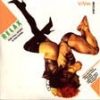 For V/VM this is love in the time of controversy, and it's especiallyfitting for them to be making some of the hottest music of theircareers while in the hottest water yet. After I obtained a copy of thisnow rare commodity through means I will not disclose — a process othersmight find difficult, as well — I immediately dimmed the lights andfired up the candles and twinkle lights to get in the right mood forthis revisiting of the Frankie Goes to Hollywood classic. Truth betold, I knew my body was about to be rocked, just not this hard and notwith so much of a history lesson involved. This being the 20thanniversary of the original release of "Relax," it seems V/VM wanted toshare some of the more interesting tidbits of the single's background,and some of the controversy that surrounded it, as well. Hence, theartwork that closely resembles the sleeve of the Frankie single, andsamples throughout the remixes of radio programmer reactions and otherstrangeness. As for the digital reconstruction that is the musicitself, I was floored by some of the showmanship involved. V/VM havegathered remixes from a number of manipulators, including Animal,Toecutter, Shitmat, The Alien Porno Midgets and more that succeed incapturing the essence of the track and then obliterating allconceptions about it. Several of the tracks don't even feature the wordthat is the song's title, cutting and splicing the bassline and choiceother phrases, creating a neo-stomp in pasting it all back together.There's odd combinations to be sure, but they work so well: the uses of"Auld Lang Syne" and "Smoke on the Water" are particularly noteworthyfor their originality and creation of an irreplaceable leitmotif in mybrain. Where other V/VM releases have seemed to pick apart and mock theartist in question, I felt that this was an earnest homage to theorginal and to the process of remixing in general. This is more of astatement than V/VM have ever made, and it hits on all levels; thusunintentionally they defy the issue that makes it difficult to find inthe first place, as well as those responsible for it.
For V/VM this is love in the time of controversy, and it's especiallyfitting for them to be making some of the hottest music of theircareers while in the hottest water yet. After I obtained a copy of thisnow rare commodity through means I will not disclose — a process othersmight find difficult, as well — I immediately dimmed the lights andfired up the candles and twinkle lights to get in the right mood forthis revisiting of the Frankie Goes to Hollywood classic. Truth betold, I knew my body was about to be rocked, just not this hard and notwith so much of a history lesson involved. This being the 20thanniversary of the original release of "Relax," it seems V/VM wanted toshare some of the more interesting tidbits of the single's background,and some of the controversy that surrounded it, as well. Hence, theartwork that closely resembles the sleeve of the Frankie single, andsamples throughout the remixes of radio programmer reactions and otherstrangeness. As for the digital reconstruction that is the musicitself, I was floored by some of the showmanship involved. V/VM havegathered remixes from a number of manipulators, including Animal,Toecutter, Shitmat, The Alien Porno Midgets and more that succeed incapturing the essence of the track and then obliterating allconceptions about it. Several of the tracks don't even feature the wordthat is the song's title, cutting and splicing the bassline and choiceother phrases, creating a neo-stomp in pasting it all back together.There's odd combinations to be sure, but they work so well: the uses of"Auld Lang Syne" and "Smoke on the Water" are particularly noteworthyfor their originality and creation of an irreplaceable leitmotif in mybrain. Where other V/VM releases have seemed to pick apart and mock theartist in question, I felt that this was an earnest homage to theorginal and to the process of remixing in general. This is more of astatement than V/VM have ever made, and it hits on all levels; thusunintentionally they defy the issue that makes it difficult to find inthe first place, as well as those responsible for it. With her previous full-lengths, Head Slash Bauch and Westernization Completed,Antye Greie-Fuchs proved entirely capable of creating beautiful andunique electronic music without the help of her Laub bandmate Von Jotkaor frequent collaborator Vladislav Delay. Reaching an early peak onlast year's Westernization, AGF's mature style is both morechallenging than her past work and more rewarding. The increasinglyabstract free-association of Greie's characteristic speak-singing seemsto have found perfect accompaniment in a new loosening of songstructure which, instead of dissolving substance, allows for thecareful buttressing of her words with basic and unclutteredsound-forms, accentuating the language and aligning the music moreclosely with the power of suggestion. The "instrumental" portion ofAGF's music remains a recognizably laptop-based affair, full of crisp,bass-less beats, clean synth-like melodic lines, and a delicateunderpinning of digital drone and flutter; however on Westernization and to a greater degree on Language is the Most,these elements are treated with greater economy of use, layered lessfrequently or abundantly, and approached with more attention to varietyand improvisational flow. It's as if Greie treats instrumental soundlike it were part of her vocal, as if these melodic shards and openrhythms have assumed fixed places in the artist's advancing word bank,lent the same concise, charged delivery as her speech. This effect isconsistent with the broader theme of Language is the Most,essentially a live recording from AGF's performance at the ArsElectronica Festival's Klangpark in 2003. The theme of the festivallast year was "Code - The Language of Our Time," and it's hard toimagine an musician engaged in a more literal dialogue between digitalcode, musical composition, and spoken language than Antye Greie. Westernization is as much sound poetry as it is patient left-field electronica, and Languagemakes the distinction even more complicated. The live setup, by forceor by choice, has Greie's voice appearing with less regularity and lessreliance on structural cues, creating music whose success is largelyreliant on the tact of the artist's speech and the resonance of herwords taken alone. Her compositions progress along astream-of-consciousness logic, incorporating numerous field recordings,samples and organic-sounding clatter to make Language AGF'smost complex listen to date, despite the equally unprecedented amountof open space appearing throughout. Compounding the event's thematicinterest in coded language, text, and the relevancy of establishedcommunication methods, Greie incorporates pieces of Westernization, as good a document of the artist's own "language" as any, into her live set. This decision has ended up granting Languagesomething of a "companion piece"-status, and while I'd be more likelyto recommend the former to new listeners, the live disc has provided anequal amount of rapturous listening and contains the seeds of newrefinement in AGF's sound, making it just as essential.
With her previous full-lengths, Head Slash Bauch and Westernization Completed,Antye Greie-Fuchs proved entirely capable of creating beautiful andunique electronic music without the help of her Laub bandmate Von Jotkaor frequent collaborator Vladislav Delay. Reaching an early peak onlast year's Westernization, AGF's mature style is both morechallenging than her past work and more rewarding. The increasinglyabstract free-association of Greie's characteristic speak-singing seemsto have found perfect accompaniment in a new loosening of songstructure which, instead of dissolving substance, allows for thecareful buttressing of her words with basic and unclutteredsound-forms, accentuating the language and aligning the music moreclosely with the power of suggestion. The "instrumental" portion ofAGF's music remains a recognizably laptop-based affair, full of crisp,bass-less beats, clean synth-like melodic lines, and a delicateunderpinning of digital drone and flutter; however on Westernization and to a greater degree on Language is the Most,these elements are treated with greater economy of use, layered lessfrequently or abundantly, and approached with more attention to varietyand improvisational flow. It's as if Greie treats instrumental soundlike it were part of her vocal, as if these melodic shards and openrhythms have assumed fixed places in the artist's advancing word bank,lent the same concise, charged delivery as her speech. This effect isconsistent with the broader theme of Language is the Most,essentially a live recording from AGF's performance at the ArsElectronica Festival's Klangpark in 2003. The theme of the festivallast year was "Code - The Language of Our Time," and it's hard toimagine an musician engaged in a more literal dialogue between digitalcode, musical composition, and spoken language than Antye Greie. Westernization is as much sound poetry as it is patient left-field electronica, and Languagemakes the distinction even more complicated. The live setup, by forceor by choice, has Greie's voice appearing with less regularity and lessreliance on structural cues, creating music whose success is largelyreliant on the tact of the artist's speech and the resonance of herwords taken alone. Her compositions progress along astream-of-consciousness logic, incorporating numerous field recordings,samples and organic-sounding clatter to make Language AGF'smost complex listen to date, despite the equally unprecedented amountof open space appearing throughout. Compounding the event's thematicinterest in coded language, text, and the relevancy of establishedcommunication methods, Greie incorporates pieces of Westernization, as good a document of the artist's own "language" as any, into her live set. This decision has ended up granting Languagesomething of a "companion piece"-status, and while I'd be more likelyto recommend the former to new listeners, the live disc has provided anequal amount of rapturous listening and contains the seeds of newrefinement in AGF's sound, making it just as essential.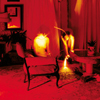 When feeling below the weather, this is the kind of sound that managesto pick me up and put me at peace. The cool, glass melodies andrainforest rhythms never cascade out of control leaving only the breezeand scent of spring in their wake. Calling "Über Die Wasserscheide" agentle ride might leave the impression that Cicadidaeis a simple record, but the masterful combination of live instrumentswith electronic moans is anything but that. Kammerflimmer Kollektiefhave an ear for space and fluidity — short tracks like "Blood" relate auniverse of thoughts and feelings in just over a minute while "...DennNacht Ist Jetzt Schon Bald!" unfolds in acoustic strips and wandering,mystical drum patterns. The weave of patterns andstream-of-consciousness noise-melodies play well with eachother, neverchoking out one another and never floundering in chaos; each second ofsound plays an important part in the song at just the right time. Denseor heavier moments always find themselves relieved in the caress of awoodwind instrument or the lazy kiss of a strummed guitar. "Sie TrankenRegen (Version)" ushers forth like cigarette smoke, slowly expandingthrough the room, tasting of memories, and shrouded in mystery — thedrumming pulsing from beneath a veil of jazz and the horns hover overthe lullaby of a lustful saxophone. The residue this record leavesbehind sticks to the walls and reverberates perpetually until finallyit seeps into the blood and animates the mind. Though melancholy findsits way onto the record, its the sort of sadness that only serves torejuvinate the soul and lift it back to its feet. As a little addedbonus, the latter portion of the record unfolds into a sultry dancethat can only be called sexy. Late-night excursions and secret thoughtscourse throughout "Mantra" and "Edierdaunen (Gerupft)." The variety ofcharacter that marks these songs stand out as one of the records beststrengths. There is a unique quality to the production,instrumentation, and arrangement of each tune that cannot beoverlooked.
When feeling below the weather, this is the kind of sound that managesto pick me up and put me at peace. The cool, glass melodies andrainforest rhythms never cascade out of control leaving only the breezeand scent of spring in their wake. Calling "Über Die Wasserscheide" agentle ride might leave the impression that Cicadidaeis a simple record, but the masterful combination of live instrumentswith electronic moans is anything but that. Kammerflimmer Kollektiefhave an ear for space and fluidity — short tracks like "Blood" relate auniverse of thoughts and feelings in just over a minute while "...DennNacht Ist Jetzt Schon Bald!" unfolds in acoustic strips and wandering,mystical drum patterns. The weave of patterns andstream-of-consciousness noise-melodies play well with eachother, neverchoking out one another and never floundering in chaos; each second ofsound plays an important part in the song at just the right time. Denseor heavier moments always find themselves relieved in the caress of awoodwind instrument or the lazy kiss of a strummed guitar. "Sie TrankenRegen (Version)" ushers forth like cigarette smoke, slowly expandingthrough the room, tasting of memories, and shrouded in mystery — thedrumming pulsing from beneath a veil of jazz and the horns hover overthe lullaby of a lustful saxophone. The residue this record leavesbehind sticks to the walls and reverberates perpetually until finallyit seeps into the blood and animates the mind. Though melancholy findsits way onto the record, its the sort of sadness that only serves torejuvinate the soul and lift it back to its feet. As a little addedbonus, the latter portion of the record unfolds into a sultry dancethat can only be called sexy. Late-night excursions and secret thoughtscourse throughout "Mantra" and "Edierdaunen (Gerupft)." The variety ofcharacter that marks these songs stand out as one of the records beststrengths. There is a unique quality to the production,instrumentation, and arrangement of each tune that cannot beoverlooked.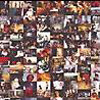 Those expecting Black Dice to travel further in the trajectory suggested by the beat-infused abrasiveness of Cone Toaster will no doubt be disappointed by Miles of Smiles. Black Dice's newest 12" on DFA is not very similar to the material on the aforementioned EP, and it doesn't share much in common with the blissful psychedelic clamor of their Beaches and Canyons album, either. It's something else entirely, an unexpected tangent into the realm of sampling and tape music.
Those expecting Black Dice to travel further in the trajectory suggested by the beat-infused abrasiveness of Cone Toaster will no doubt be disappointed by Miles of Smiles. Black Dice's newest 12" on DFA is not very similar to the material on the aforementioned EP, and it doesn't share much in common with the blissful psychedelic clamor of their Beaches and Canyons album, either. It's something else entirely, an unexpected tangent into the realm of sampling and tape music.
 Newest addition to the most sparsely-populated of Ground Fault's threeseries headings (series III, the "harsh noise" category), Shipwrecker's Diarycertainly justifies its placement. Providence's Prurient (aka DominickFernow) is a learned student in the brutal school of power electronics,but one whose intentions lie more in the head-cleaning, catharticcorner of the genre than in the kind sensationalism practiced by othernotables like Deathpile, who has recorded for Fernow's own HospitalProductions. The noise on Shipwrecker's tends to occupy ahigh-frequency range with layers of crisp static making a thick cushionfor most of the other activity and keeping the whole from sinking intothe doom-y sludge that is a popular pitfall for others working in thismedium. No sounds reach truly cringe-inducing, spectrum-piercinglevels, making the disc highly listenable following a short adjustmentperiod. Once inside, there's enough nuance and careful construction tomake for a very rewarding noise record. It's clear that Fernow favorsnot the guttural thrash of people like Deathpile or the explicit,confrontational side of the genre, as embodied (still) by Whitehouse.Instead, he works with less-concentrated, incremental noise, usingspeed and a more gradual, swarming approach to achieve his desiredeffect, which is every bit as powerful as his peers' though less likelyto get bogged down in bad posturing. It's interesting to try and dividethe 33-minute Shipwrecker's into two conceptual halves. Thefirst eight tracks offer the disc's grittiest noise, crumbling staticwaves and washes that develop patiently enough to sound almost capableof being touched or traced with the hand. This is unrelenting, physicalnoise, and Fernow knows it, naming each track after a part of the body,starting with "Shin" and moving up to "Elbow." There is, despite thesheer mass of sound bombarding the ears, a level of comfort availablein the "material" quality of the noise during this half. However with"June 19," Prurient moves on, breaking the connection with the body andallowing the sound to bottom out considerably, leaving only a scorchedwhine and weighted hiss, allying him more with the current crop ofMidwestern homemade noisemakers than with the stoic "power" camp.Following the track's interlude, Fernow's familiar face returns for thedisc's most harrowing section, a 4-track blitzkrieg run through wildlypunctuated bursts, quickly modulated pitch shifts and blasted vocalyelps. For titles, the artist returns to the body, but is now localizedat the head ("Earlobe," "Jaw"), suggesting to me that, from the basephysicality of Shipwrecker's first half, Prurient has moved nowto a site of deeper mental anguish, hence the obsession with the headand the tortured quality of the music in the latter half. In myunderstanding, "June 19" arrives midway as bitter introduction to theworld of the mind, like a repressed memory, foregrounding the nakedemotion that arrives with the disc's closing tracks, two unalteredanswering machine messages left by a young girl. They are late-nightlove messages, innocent, tender, and certainly in contrast with thehellish vision that preceded them. And while some may find Fernow'sconclusion too "neat" or explicit as a thematic rendering, these tracksdo help establish what was suspected before, that Prurient is, atleast, one of the more introspective or "personal" noise artistsworking today, if not the kinder, gentler new face of powerelectronics.
Newest addition to the most sparsely-populated of Ground Fault's threeseries headings (series III, the "harsh noise" category), Shipwrecker's Diarycertainly justifies its placement. Providence's Prurient (aka DominickFernow) is a learned student in the brutal school of power electronics,but one whose intentions lie more in the head-cleaning, catharticcorner of the genre than in the kind sensationalism practiced by othernotables like Deathpile, who has recorded for Fernow's own HospitalProductions. The noise on Shipwrecker's tends to occupy ahigh-frequency range with layers of crisp static making a thick cushionfor most of the other activity and keeping the whole from sinking intothe doom-y sludge that is a popular pitfall for others working in thismedium. No sounds reach truly cringe-inducing, spectrum-piercinglevels, making the disc highly listenable following a short adjustmentperiod. Once inside, there's enough nuance and careful construction tomake for a very rewarding noise record. It's clear that Fernow favorsnot the guttural thrash of people like Deathpile or the explicit,confrontational side of the genre, as embodied (still) by Whitehouse.Instead, he works with less-concentrated, incremental noise, usingspeed and a more gradual, swarming approach to achieve his desiredeffect, which is every bit as powerful as his peers' though less likelyto get bogged down in bad posturing. It's interesting to try and dividethe 33-minute Shipwrecker's into two conceptual halves. Thefirst eight tracks offer the disc's grittiest noise, crumbling staticwaves and washes that develop patiently enough to sound almost capableof being touched or traced with the hand. This is unrelenting, physicalnoise, and Fernow knows it, naming each track after a part of the body,starting with "Shin" and moving up to "Elbow." There is, despite thesheer mass of sound bombarding the ears, a level of comfort availablein the "material" quality of the noise during this half. However with"June 19," Prurient moves on, breaking the connection with the body andallowing the sound to bottom out considerably, leaving only a scorchedwhine and weighted hiss, allying him more with the current crop ofMidwestern homemade noisemakers than with the stoic "power" camp.Following the track's interlude, Fernow's familiar face returns for thedisc's most harrowing section, a 4-track blitzkrieg run through wildlypunctuated bursts, quickly modulated pitch shifts and blasted vocalyelps. For titles, the artist returns to the body, but is now localizedat the head ("Earlobe," "Jaw"), suggesting to me that, from the basephysicality of Shipwrecker's first half, Prurient has moved nowto a site of deeper mental anguish, hence the obsession with the headand the tortured quality of the music in the latter half. In myunderstanding, "June 19" arrives midway as bitter introduction to theworld of the mind, like a repressed memory, foregrounding the nakedemotion that arrives with the disc's closing tracks, two unalteredanswering machine messages left by a young girl. They are late-nightlove messages, innocent, tender, and certainly in contrast with thehellish vision that preceded them. And while some may find Fernow'sconclusion too "neat" or explicit as a thematic rendering, these tracksdo help establish what was suspected before, that Prurient is, atleast, one of the more introspective or "personal" noise artistsworking today, if not the kinder, gentler new face of powerelectronics.  "Celestial Highway" is a massive, stomping heavy metal riff, a bighairy acid-drenched slab of fuzzy blues cribbed from the Blue Cheerhandbook. The jacked-up shredding that twists around the centralrhythmic stomp is directly inspired by the third-eye Satanic soloing ofGlenn Tipton and Tony Iommi. That shit keeps cycling around, pulsatingfuzzy tendrils of bombastic riffage, hairy to the Nth degree, liftingup to the clouds on a silver machine of over-amped guitar wreckage. Andthen it repeats. Over and over. For nearly an hour. Matthew Bower'snewest album under the Skullflower banner earns its title. Not for thepatience-challenged, Exquisite Fucking Boredomtests the limits of repetition. Applying the techniques of theavant-garde repetitive techniques of Steve Reich and Terry Riley tonoisy psych-rock has been tried before, most memorably on Acid MothersTemple's reading of Riley's monumental In C. But I must confessthat Bower has done them one better with the four-part suite of"Celestial Highway," which sets a new record for trance-rock. Even moreexasperating that Spinal Tap's wanky Jazz Odyssey, Skullfloweris pushing the envelope of acceptability in terms of musical content. Ithink it pays off brilliantly, but whether or not the average listenerwill agree depends upon their temperament. The nuanced production is byColin Potter, the genius engineer and producer behind some of NurseWith Wound's best work. Potter's technique is to add sheets ofcompounding noise run-off to each successive riff, alternately buryingthe cyclical guitars in a pile of audio rubble, or uncovering andhighlighting them by pushing out the borders of distortion. It's notfor the faint of heart, but over the course of the album, it ascends toa hypnotic level of transcendence. Like a lot of ethnic and avant-gardetrance music, the eventual goal is for the listener to ignore thecentral repeating theme, which fades like white noise to thebackground, focusing instead on the gradual evolution of sound, or inthe case of Skullflower's album, the compounding noise, distortion anddecay that creep in over the course of the four-part suite. Patience isa virtue, and in the case of Exquisite Fucking Boredom, it's avirtue that eventually rewards the listener with some of the mostbizarre and unconventional "stoner rock" yet conceived.
"Celestial Highway" is a massive, stomping heavy metal riff, a bighairy acid-drenched slab of fuzzy blues cribbed from the Blue Cheerhandbook. The jacked-up shredding that twists around the centralrhythmic stomp is directly inspired by the third-eye Satanic soloing ofGlenn Tipton and Tony Iommi. That shit keeps cycling around, pulsatingfuzzy tendrils of bombastic riffage, hairy to the Nth degree, liftingup to the clouds on a silver machine of over-amped guitar wreckage. Andthen it repeats. Over and over. For nearly an hour. Matthew Bower'snewest album under the Skullflower banner earns its title. Not for thepatience-challenged, Exquisite Fucking Boredomtests the limits of repetition. Applying the techniques of theavant-garde repetitive techniques of Steve Reich and Terry Riley tonoisy psych-rock has been tried before, most memorably on Acid MothersTemple's reading of Riley's monumental In C. But I must confessthat Bower has done them one better with the four-part suite of"Celestial Highway," which sets a new record for trance-rock. Even moreexasperating that Spinal Tap's wanky Jazz Odyssey, Skullfloweris pushing the envelope of acceptability in terms of musical content. Ithink it pays off brilliantly, but whether or not the average listenerwill agree depends upon their temperament. The nuanced production is byColin Potter, the genius engineer and producer behind some of NurseWith Wound's best work. Potter's technique is to add sheets ofcompounding noise run-off to each successive riff, alternately buryingthe cyclical guitars in a pile of audio rubble, or uncovering andhighlighting them by pushing out the borders of distortion. It's notfor the faint of heart, but over the course of the album, it ascends toa hypnotic level of transcendence. Like a lot of ethnic and avant-gardetrance music, the eventual goal is for the listener to ignore thecentral repeating theme, which fades like white noise to thebackground, focusing instead on the gradual evolution of sound, or inthe case of Skullflower's album, the compounding noise, distortion anddecay that creep in over the course of the four-part suite. Patience isa virtue, and in the case of Exquisite Fucking Boredom, it's avirtue that eventually rewards the listener with some of the mostbizarre and unconventional "stoner rock" yet conceived.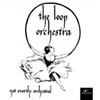 The first interesting thing about Not Overtly Orchestralis the black-and-white photo on back of the disc, framing tworeel-to-reel tape decks, fastened to a bare wall about 20 feet apartand running a visibly stretched loop of tape across the expanse.Whether or not the six members of The Loop Orchestra actually performusing loops this large does not determine the success of their music;however, a healthy love of loops, odd juxtapositions, distortedlayerings, and nostalgia might create the perfect predisposition. LoopOrchestra are from Australia, with members who've played in theoft-overlooked experimental/industrial/newwave outfit Severed Heads,and like that band's more challenging 12" platters, Not Overtly Orchestralis heavy on clipped, semi-nauseous repetitions, loops meant to definethemselves as loops first and foremost, with any mood-making orillusionism purely secondary. The Orchestra work exclusively withreel-to-reel decks, a process that all but guarantees their primitivetechnique, by which various loops are slowly layered, fading in and outto create tracks that progress (depending on tact and intention) in ausually fluid, ever-changing fashion. While they lack most of theHeads' mechanical rigidity and long-windedness, Loop Orchestra'sslippery sense of humor and interest in all things arcane andincompatible seems directly related to their fellow countrymen. I amhesitant to compare this disc to other loop-centric, antiquatedtechnologists like (the now obvious) Philip Jeck because the appealhere feels more esoteric, more heavily reliant on the kitsch factor.Tape-loop composition is a tried, age-old technique, making The LoopOrchestra worthy of praise mainly because of the increasingly bizarrenature of the sounds used. The opening "Son of Not Overtly Orchestra"establishes its initial mood with a choir of hazy stringed instrumentswhich are slowly and nervously assimilated into a factory noisescape,eventually locking into submission as a few wailing guitars initiatethe track's calamitous end. The track acts as a pleasant preamble tothe weirdness that will dominate the rest of the disc. "Radiophony" isa 15-minute piece created from, and in tribute to, the BBC RadiophonicWorkshop's archival recordings. The Orchestra approaches this sourcematerial the way Stock, Hausen, & Walkman might, isolating thestrangest of the Workshop's creations, from abstract animal voices towonderfully dated space-age trumpet sounds and a library's worth ofgrainy, analogue atmospherics, stretching and piling each bit of tapeinto a surreal tour-de-force that those bearded Brits could never havedreamed up. The disc's real gem, though, is "Profiles," the longest ofthe four pieces and one that clarifies the Orchestra's devotion to campand all things peculiar. It is a vast collage of vocal sounds, rangingfrom piercing screams to breathy grunts and warped speech, piecedtogether in a staggering, drug-damaged spew, rife with churning aquaticnoise and other field captures. The track is a perfect summation of thegroup's interests, further into leftfield than they initially appearand completely capable of breathing freshness into tired styles andobsolete devices.
The first interesting thing about Not Overtly Orchestralis the black-and-white photo on back of the disc, framing tworeel-to-reel tape decks, fastened to a bare wall about 20 feet apartand running a visibly stretched loop of tape across the expanse.Whether or not the six members of The Loop Orchestra actually performusing loops this large does not determine the success of their music;however, a healthy love of loops, odd juxtapositions, distortedlayerings, and nostalgia might create the perfect predisposition. LoopOrchestra are from Australia, with members who've played in theoft-overlooked experimental/industrial/newwave outfit Severed Heads,and like that band's more challenging 12" platters, Not Overtly Orchestralis heavy on clipped, semi-nauseous repetitions, loops meant to definethemselves as loops first and foremost, with any mood-making orillusionism purely secondary. The Orchestra work exclusively withreel-to-reel decks, a process that all but guarantees their primitivetechnique, by which various loops are slowly layered, fading in and outto create tracks that progress (depending on tact and intention) in ausually fluid, ever-changing fashion. While they lack most of theHeads' mechanical rigidity and long-windedness, Loop Orchestra'sslippery sense of humor and interest in all things arcane andincompatible seems directly related to their fellow countrymen. I amhesitant to compare this disc to other loop-centric, antiquatedtechnologists like (the now obvious) Philip Jeck because the appealhere feels more esoteric, more heavily reliant on the kitsch factor.Tape-loop composition is a tried, age-old technique, making The LoopOrchestra worthy of praise mainly because of the increasingly bizarrenature of the sounds used. The opening "Son of Not Overtly Orchestra"establishes its initial mood with a choir of hazy stringed instrumentswhich are slowly and nervously assimilated into a factory noisescape,eventually locking into submission as a few wailing guitars initiatethe track's calamitous end. The track acts as a pleasant preamble tothe weirdness that will dominate the rest of the disc. "Radiophony" isa 15-minute piece created from, and in tribute to, the BBC RadiophonicWorkshop's archival recordings. The Orchestra approaches this sourcematerial the way Stock, Hausen, & Walkman might, isolating thestrangest of the Workshop's creations, from abstract animal voices towonderfully dated space-age trumpet sounds and a library's worth ofgrainy, analogue atmospherics, stretching and piling each bit of tapeinto a surreal tour-de-force that those bearded Brits could never havedreamed up. The disc's real gem, though, is "Profiles," the longest ofthe four pieces and one that clarifies the Orchestra's devotion to campand all things peculiar. It is a vast collage of vocal sounds, rangingfrom piercing screams to breathy grunts and warped speech, piecedtogether in a staggering, drug-damaged spew, rife with churning aquaticnoise and other field captures. The track is a perfect summation of thegroup's interests, further into leftfield than they initially appearand completely capable of breathing freshness into tired styles andobsolete devices.  Two former members of Arab Strap strike out on their own as Sons andDaughters, and if their debut is any indication they'll be just finefrom here on out. Adele Bethel and David Gow are not necessarilywell-known for their time touring with the Strap, but with theirfriends and bandmates they craft their own brand ofcountry/folk/blues/rock romp and stomp that's just quirky enough tokeep me coming back for more. With other singer and guitar player ScottPaterson, Bethel makes rather lovely harmonies over tunes that varyfrom all-out bombastic knee-slappers to tributes to Johnny Cash. It'stantamount to the best bar band I've heard in my life, where I'd be aregular singing along to all the songs, cursing the tourists who don'tknow what glory they're talking through. That's not to diminish theirskills any, as any bar would be lucky to have an ensemble like thisin-house. From the outset, I was ready to dance and shake with a beerin one hand and a girly in the other, as the steady rhythm of "Fight"has all the feel of a do-si-do gone wrong. "The lines are drawn, thisis getting worse" immediately precedes a call-out of "Uh huh uh huh,"and it's destined for call and response at any show. Bethel has a liltin her voice that just beckons, but there's always a hint of somethingmuch more that can be unleashed at any moment. Paterson, then, is theperfect foil, all accented awkward thuds but still perfectly suited tothe sounds beneath. It's the frenetic energy, that hesitation of what'snext, that brings about the real power in this band. The tempos of thesongs are very similar, but they take off in wildly differentdirections, so it's of no concern. Just like that, though, the recordis over: it's seven songs of easy aggression and power harmonies, andhooks in my head for days.
Two former members of Arab Strap strike out on their own as Sons andDaughters, and if their debut is any indication they'll be just finefrom here on out. Adele Bethel and David Gow are not necessarilywell-known for their time touring with the Strap, but with theirfriends and bandmates they craft their own brand ofcountry/folk/blues/rock romp and stomp that's just quirky enough tokeep me coming back for more. With other singer and guitar player ScottPaterson, Bethel makes rather lovely harmonies over tunes that varyfrom all-out bombastic knee-slappers to tributes to Johnny Cash. It'stantamount to the best bar band I've heard in my life, where I'd be aregular singing along to all the songs, cursing the tourists who don'tknow what glory they're talking through. That's not to diminish theirskills any, as any bar would be lucky to have an ensemble like thisin-house. From the outset, I was ready to dance and shake with a beerin one hand and a girly in the other, as the steady rhythm of "Fight"has all the feel of a do-si-do gone wrong. "The lines are drawn, thisis getting worse" immediately precedes a call-out of "Uh huh uh huh,"and it's destined for call and response at any show. Bethel has a liltin her voice that just beckons, but there's always a hint of somethingmuch more that can be unleashed at any moment. Paterson, then, is theperfect foil, all accented awkward thuds but still perfectly suited tothe sounds beneath. It's the frenetic energy, that hesitation of what'snext, that brings about the real power in this band. The tempos of thesongs are very similar, but they take off in wildly differentdirections, so it's of no concern. Just like that, though, the recordis over: it's seven songs of easy aggression and power harmonies, andhooks in my head for days. Exotica has never quite grown beyond its initial renaissance ofinterest in the early 90's. Even among its most avid fans andcollectors, it's still considered something of a novelty: mildlydiverting, but ultimately disposable musical kitsch. Recent attempts atresurrecting exotica by John Zorn and Tipsy have been a little tooreverent for their own good - studied facsimiles of 1950's exotica byMartin Denny or Les Baxter - largely academic with zero soul orsincerity.
Exotica has never quite grown beyond its initial renaissance ofinterest in the early 90's. Even among its most avid fans andcollectors, it's still considered something of a novelty: mildlydiverting, but ultimately disposable musical kitsch. Recent attempts atresurrecting exotica by John Zorn and Tipsy have been a little tooreverent for their own good - studied facsimiles of 1950's exotica byMartin Denny or Les Baxter - largely academic with zero soul orsincerity. Sam Beam, the man behind Iron & Wine, has changed his approach onthis, his second full-length album. The previous album featured Beam onhis own, playing the instruments (primarily guitar and banjo) andrecording at home on a 4-track. Our Endless Numbered Daysfinds him employing the help of the musicians who accompany him in liveperformances, playing a wider variety of instruments, and recording ina studio. Although this allows Beam to broaden his horizons musically,it seems that in the process his new material suffers from being lesspersonal and more watered-down. Though Beam tends to wear his gentlyfolky influences on his sleeve (i.e. Nick Drake and Tim Buckley), hesucceeds in making the style into something which is unique. "On YourWings," which kicks the album off to a promising start, soon peters outinto the wimpy "Naked As We Came," which is musically along the linesof I&W's first records, but overpowered by maudlin lyrics.Unfortunately, Our Endless Numbered Days is hard pressed torecover the initial spark with which it began. That is not to say thatthe album is wholly without merit. "Teeth in the Grass" has an earthycharm, and "Each Coming Night" is beautiful, albeit brief return toform. Sadly, however, these are the exception and not the rule.
Sam Beam, the man behind Iron & Wine, has changed his approach onthis, his second full-length album. The previous album featured Beam onhis own, playing the instruments (primarily guitar and banjo) andrecording at home on a 4-track. Our Endless Numbered Daysfinds him employing the help of the musicians who accompany him in liveperformances, playing a wider variety of instruments, and recording ina studio. Although this allows Beam to broaden his horizons musically,it seems that in the process his new material suffers from being lesspersonal and more watered-down. Though Beam tends to wear his gentlyfolky influences on his sleeve (i.e. Nick Drake and Tim Buckley), hesucceeds in making the style into something which is unique. "On YourWings," which kicks the album off to a promising start, soon peters outinto the wimpy "Naked As We Came," which is musically along the linesof I&W's first records, but overpowered by maudlin lyrics.Unfortunately, Our Endless Numbered Days is hard pressed torecover the initial spark with which it began. That is not to say thatthe album is wholly without merit. "Teeth in the Grass" has an earthycharm, and "Each Coming Night" is beautiful, albeit brief return toform. Sadly, however, these are the exception and not the rule. 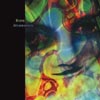 This 1990 live recording documents an interesting moment in the history of one of the U.S.?s most interesting and long-standing avant-garde collectives. Under the early tutelage of Chris Cutler, the Colorado-based group has, since 1979, produced a wealth of music rooted in the early admirer/member's progressive legacy, an elusive, genre-bending approach with a particular emphasis on rustic folk-pop and dark, frayed psychedelia.
This 1990 live recording documents an interesting moment in the history of one of the U.S.?s most interesting and long-standing avant-garde collectives. Under the early tutelage of Chris Cutler, the Colorado-based group has, since 1979, produced a wealth of music rooted in the early admirer/member's progressive legacy, an elusive, genre-bending approach with a particular emphasis on rustic folk-pop and dark, frayed psychedelia.
 Though the policies of containment kept the political and geographicalboundaries of free thought and fascist oppression clearly defined inthe early 1980's, the strength of the iron curtain was not enough toprevent ideas from crossing into and beyond the bloc. Begnagrad iscomprised of members who were all exposed to the burgeoning punk andprogressive rock music scenes in their hometown of Ljubljana, Slovenia,then part of communist Yugoslavia. The band is the product of fivedaring multi-instrumentalists who combined Alpine and Eastern Europeanfolk concepts with modern rock, free-jazz influences and a distinctsense of whimsy. Their self-titled album, originally released in 1982,is a fascinating example of the creative minds and wonderful ideas thatflourished in less pleasant times and circumstances. The tracks theyproduced are impressively intricate, with numerous instruments spinningoff around each other in a complex weave of sound and rhythm. "Pjan ska/ Drinking One" begins with a swirling arrangement, accordions andwoodwinds etching out those alpine peaks as they rise and fall beforelaunching into a full steam ahead horn sprint, as if James Chance werefronting a Bohemian (geographically, that is) dance ensemble. Finallyspliced with the enthusiastic mock yodeling of the band members, "Pjanska" spends itself in an amusing gasp of grinning energy. "Bo Ze (CeBo) / All's Good (Maybe)" is a relentlessly charming track, whoseloping, oscillating bass rhythm inspires the urge to make jaunty,whirling circles, arms linked with another in the midst of coy, flirtydance. What makes Begnagradsuch an engaging, satisfying listen is the pure joy that emanates fromthe music, a sense of deeply passionate humanism that can often be lostin experimental, fusion, and avant-garde music. This feeling isexemplified in two live bonus tracks that document the band on aEuropean tour. "Tazadnatanova / Thelastnewone" is an intense,rollicking piece that is driven by a furious punk rock energy, squallswith saxophone riffage and sputters about on jagged, post-punk guitars,but ultimately is fully entrenched in the warmth and togetherness ofthe band's folk-troubadour roots. The band launches into a frantic jig,pushing themselves and their audience to clap along and dance withmanic energy. The crowd can be heard clapping, whistling, hooting, andpouring themselves heart and soul into the song. Potentially thehappiest record I have heard in a very long while, Beganagradmanages to be progressive by utilizing the past, finding the originalmotivator for musical expression: to entertain, to bring peopletogether, and make them feel as if they are involved in somethingbeautiful.
Though the policies of containment kept the political and geographicalboundaries of free thought and fascist oppression clearly defined inthe early 1980's, the strength of the iron curtain was not enough toprevent ideas from crossing into and beyond the bloc. Begnagrad iscomprised of members who were all exposed to the burgeoning punk andprogressive rock music scenes in their hometown of Ljubljana, Slovenia,then part of communist Yugoslavia. The band is the product of fivedaring multi-instrumentalists who combined Alpine and Eastern Europeanfolk concepts with modern rock, free-jazz influences and a distinctsense of whimsy. Their self-titled album, originally released in 1982,is a fascinating example of the creative minds and wonderful ideas thatflourished in less pleasant times and circumstances. The tracks theyproduced are impressively intricate, with numerous instruments spinningoff around each other in a complex weave of sound and rhythm. "Pjan ska/ Drinking One" begins with a swirling arrangement, accordions andwoodwinds etching out those alpine peaks as they rise and fall beforelaunching into a full steam ahead horn sprint, as if James Chance werefronting a Bohemian (geographically, that is) dance ensemble. Finallyspliced with the enthusiastic mock yodeling of the band members, "Pjanska" spends itself in an amusing gasp of grinning energy. "Bo Ze (CeBo) / All's Good (Maybe)" is a relentlessly charming track, whoseloping, oscillating bass rhythm inspires the urge to make jaunty,whirling circles, arms linked with another in the midst of coy, flirtydance. What makes Begnagradsuch an engaging, satisfying listen is the pure joy that emanates fromthe music, a sense of deeply passionate humanism that can often be lostin experimental, fusion, and avant-garde music. This feeling isexemplified in two live bonus tracks that document the band on aEuropean tour. "Tazadnatanova / Thelastnewone" is an intense,rollicking piece that is driven by a furious punk rock energy, squallswith saxophone riffage and sputters about on jagged, post-punk guitars,but ultimately is fully entrenched in the warmth and togetherness ofthe band's folk-troubadour roots. The band launches into a frantic jig,pushing themselves and their audience to clap along and dance withmanic energy. The crowd can be heard clapping, whistling, hooting, andpouring themselves heart and soul into the song. Potentially thehappiest record I have heard in a very long while, Beganagradmanages to be progressive by utilizing the past, finding the originalmotivator for musical expression: to entertain, to bring peopletogether, and make them feel as if they are involved in somethingbeautiful.  Underground hip-hop allstars cLOUDDEAD either win people over in excess or lose them completely, and their sophomore full-length isn't likely to change that much. There is no compromise in this music: there is only with or against this interesting lot.
Underground hip-hop allstars cLOUDDEAD either win people over in excess or lose them completely, and their sophomore full-length isn't likely to change that much. There is no compromise in this music: there is only with or against this interesting lot.
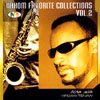 Don't ever feel afraid to strike up a conversation with afriend/associate who's not from your country about food of theircountry, a reward might be in the future. I was talking to an Ethiopianperson I knew about Ethiopian food and she told me that I must try aplace that's sort of off the beaten path, somewhat hidden and in an oddlocation in Boston, a place I had been relatively familiar with buthave never realized a good restaurant existed there. I had been to acouple other Ethiopian places in Boston, one I thought was dreadful butone I was quite fond of, however, when you get a recommendation from anEthiopian (or an Indian about Indian food, or Japanese, Mexican,etc,...), you take them up on it. So I took Jessica out for herbirthday and the food that night was fantastic. The place was full withplenty of Ethiopian patrons all talking with the staff like they werefamily, which is always a good sign. The music being played wasexcellent and by the time this one song came on, I had to get up andfind out what it was. The slap-bass and looped drum patterns weren'tmuch unlike old stuff from 23 Skidoo and I was completely in a trance.I went to the bar and the bartender wrote it down in a language Icouldn't read and told me to take the sheet of paper to the South EndFood Emporium and hand them the sheet of paper. The following day I didand ended up with this CD. It's not completely unexpected from a foodmart: the sound quality is pretty shoddy (cassette tape "breathing"sounds can be heard), the packaging looks less than legal, and there'sno web site coming up with the aforementioned URL. However, that songwhich originally stole my heart, "Wey Arada" (listen below) was wellworth the trek and worthy enough to share. The disc is a collection oftunes from this blind singer, he carries a saxophone but it's hard tohear a real sax on the disc, as a number of the songs are poorlyproduced with cheap synths. The vocal style is completely un-Western,but not dissimilar to singers of the Middle East while the music isundoubtedly African in nature, with numerous interwoven timesignatures, upbeat guitars, and keyboard instruments playing prettytones. The songs are bright and springy for the most part and it shouldgo without saying that I've got absolutely no clue what's being sung. Acouple standout tracks, like the hypnotic "Tzta," is nearly ten minutesof sheer beauty which oddly enough has to get faded out (I wonder howlong the band actually went on playing the repeated bars).Unfortunately without the web site for the label working, I've got noinformation to share about the musician nor any idea how to get itelsewhere, so, for those who find it as captivating I did, a quest inyour own city might be in order.
Don't ever feel afraid to strike up a conversation with afriend/associate who's not from your country about food of theircountry, a reward might be in the future. I was talking to an Ethiopianperson I knew about Ethiopian food and she told me that I must try aplace that's sort of off the beaten path, somewhat hidden and in an oddlocation in Boston, a place I had been relatively familiar with buthave never realized a good restaurant existed there. I had been to acouple other Ethiopian places in Boston, one I thought was dreadful butone I was quite fond of, however, when you get a recommendation from anEthiopian (or an Indian about Indian food, or Japanese, Mexican,etc,...), you take them up on it. So I took Jessica out for herbirthday and the food that night was fantastic. The place was full withplenty of Ethiopian patrons all talking with the staff like they werefamily, which is always a good sign. The music being played wasexcellent and by the time this one song came on, I had to get up andfind out what it was. The slap-bass and looped drum patterns weren'tmuch unlike old stuff from 23 Skidoo and I was completely in a trance.I went to the bar and the bartender wrote it down in a language Icouldn't read and told me to take the sheet of paper to the South EndFood Emporium and hand them the sheet of paper. The following day I didand ended up with this CD. It's not completely unexpected from a foodmart: the sound quality is pretty shoddy (cassette tape "breathing"sounds can be heard), the packaging looks less than legal, and there'sno web site coming up with the aforementioned URL. However, that songwhich originally stole my heart, "Wey Arada" (listen below) was wellworth the trek and worthy enough to share. The disc is a collection oftunes from this blind singer, he carries a saxophone but it's hard tohear a real sax on the disc, as a number of the songs are poorlyproduced with cheap synths. The vocal style is completely un-Western,but not dissimilar to singers of the Middle East while the music isundoubtedly African in nature, with numerous interwoven timesignatures, upbeat guitars, and keyboard instruments playing prettytones. The songs are bright and springy for the most part and it shouldgo without saying that I've got absolutely no clue what's being sung. Acouple standout tracks, like the hypnotic "Tzta," is nearly ten minutesof sheer beauty which oddly enough has to get faded out (I wonder howlong the band actually went on playing the repeated bars).Unfortunately without the web site for the label working, I've got noinformation to share about the musician nor any idea how to get itelsewhere, so, for those who find it as captivating I did, a quest inyour own city might be in order. 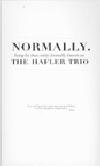 The voice of Blixa Bargeld of Einsturzende Neubauten is the rawmaterial from which Andrew McKenzie constructed the sounds on the twodiscs comprising Normally.Disc one begins with silence. Silence is merely sound that lingers justbeyond the threshold of audibility. Silence is unpotentiated space.Sound is the dissipation and usurpation of silence. When sound beginsto gradually seep into the silence of Normally, the experience is akin to the onset of a hallucination. For Normally,McKenzie is not interested in language; any whispers or screamscontributed by Mr. Bargeld are rendered indecipherable, and henceforthaffect the listener on a purely subconscious, subliminal level. This istellingly similar to the practice of talismanic magic, where theconscious desire is sublimated through a series of transformations intoirretrievably esoteric codes and diagrams, bizarre correspondences andperverted anagrams. Magic and ritual are McKenzie's primary motivationson Normally. Like the hallucinatory state, where the mind issometimes freed to make sympathetic connections between thought andmanifestation, so too the sounds on Normally contribute to anunraveled head-state in which synchronicities are the rule rather thanthe exception. At various times during my first listen to disc one, aslayers upon layers of meditational aumgns are gradually compounded, Iheard the unmistakable sounds of descending piano scales, mewlingkittens, distant muffled screams, even the sound of my front doorviolently being forced open. These were phantasms, no doubt, catalyzedby the abstract drones and ghostly monasterial choirs that McKenziesculpts. By the 28-minute mark, the piece has taken on the majesticintensity of Gyorgi Ligeti's haunting choral works, sounding like theinfinite vibratory intonations cascading from the void of space. Disctwo, or "Sphotavado," deals primarily with the breath. Just as AleisterCrowley noted after a lifetime of study devoted to the tantricmeditation, there is no better purgative than pranayama (breathcontrol), and no better way to enervate the aspirant than therepetition of mantra. Using Bargeld's mantric recitations and breathyintonations, McKenzie provides a series of distinct, dynamic passagesover the 65-minutes of the disc. Each passage fades in and out likebreathing, and each takes the listener to a more remote, rarefiedstrata of magical conception. From the gentle, reedy abstractions ofthe opening passage all the way to the serpentine, metallic Kundalinibrain-swipes of the final breath. At high volumes, many of theseprocessed sounds vibrate portions of the ear canal in an unexpectedway. I found that by moving my head back and forth, or changing myposition in the room, I could radically change the experience oflistening to "Sphotavado." McKenzie, therefore, has created a raresound sculpture which can be actively engaged and changed by thelistener. The enigmatic packaging and accompanying foldout bookletcreate a remarkable series of "blinds" that distract and mislead evenas they lay bare the central theme of Normally; words createvibrations; vibration is the result of sound; sound is the articulationof existence; existence is created by a single word, vibrated.
The voice of Blixa Bargeld of Einsturzende Neubauten is the rawmaterial from which Andrew McKenzie constructed the sounds on the twodiscs comprising Normally.Disc one begins with silence. Silence is merely sound that lingers justbeyond the threshold of audibility. Silence is unpotentiated space.Sound is the dissipation and usurpation of silence. When sound beginsto gradually seep into the silence of Normally, the experience is akin to the onset of a hallucination. For Normally,McKenzie is not interested in language; any whispers or screamscontributed by Mr. Bargeld are rendered indecipherable, and henceforthaffect the listener on a purely subconscious, subliminal level. This istellingly similar to the practice of talismanic magic, where theconscious desire is sublimated through a series of transformations intoirretrievably esoteric codes and diagrams, bizarre correspondences andperverted anagrams. Magic and ritual are McKenzie's primary motivationson Normally. Like the hallucinatory state, where the mind issometimes freed to make sympathetic connections between thought andmanifestation, so too the sounds on Normally contribute to anunraveled head-state in which synchronicities are the rule rather thanthe exception. At various times during my first listen to disc one, aslayers upon layers of meditational aumgns are gradually compounded, Iheard the unmistakable sounds of descending piano scales, mewlingkittens, distant muffled screams, even the sound of my front doorviolently being forced open. These were phantasms, no doubt, catalyzedby the abstract drones and ghostly monasterial choirs that McKenziesculpts. By the 28-minute mark, the piece has taken on the majesticintensity of Gyorgi Ligeti's haunting choral works, sounding like theinfinite vibratory intonations cascading from the void of space. Disctwo, or "Sphotavado," deals primarily with the breath. Just as AleisterCrowley noted after a lifetime of study devoted to the tantricmeditation, there is no better purgative than pranayama (breathcontrol), and no better way to enervate the aspirant than therepetition of mantra. Using Bargeld's mantric recitations and breathyintonations, McKenzie provides a series of distinct, dynamic passagesover the 65-minutes of the disc. Each passage fades in and out likebreathing, and each takes the listener to a more remote, rarefiedstrata of magical conception. From the gentle, reedy abstractions ofthe opening passage all the way to the serpentine, metallic Kundalinibrain-swipes of the final breath. At high volumes, many of theseprocessed sounds vibrate portions of the ear canal in an unexpectedway. I found that by moving my head back and forth, or changing myposition in the room, I could radically change the experience oflistening to "Sphotavado." McKenzie, therefore, has created a raresound sculpture which can be actively engaged and changed by thelistener. The enigmatic packaging and accompanying foldout bookletcreate a remarkable series of "blinds" that distract and mislead evenas they lay bare the central theme of Normally; words createvibrations; vibration is the result of sound; sound is the articulationof existence; existence is created by a single word, vibrated. When a band displays all the ferocity that could rip my muscles off mybody sinew by sinew it gets my pulse going, and that's exactly whatGuapo have on this, their fifth full-length. Recent work with CerberusShoal and the addition of a third member Daniel O'Sullivan have bothtaken Guapo down a new and risky path where they seem to let their hairdown more, worrying less about the artifice and more about the art.These songs are almost painfully direct with less noodling and inherentdistraction than previous work and the band is all the stronger for it.The one weakness is that Five Sunswears a bit thin in a few areas as a result of almost incessantrepitition — particularly on the title track, represented as one longpiece with five track separations. As a result the album cannot beendured in one sitting, but the pure aggression and brave reaching istantalizing all over. When taken in portions it is a delicious andfulfilling meal. The title track starts the record, and the firstsection features non-structured jamming with quiet keyboards and loudcymbals and gongs. Eventually the quieter moments are broken by louderdrumming and guitar noise, then a full-out sonic assault is unleashed,with distortion and deafening percussion climaxing in a loud squeal. Iwas beside myself as the song moved to its next section, a morestructured collaboration with driving bass and percussion and a playfulkeyboard. The piece itself put me in full-out sway mode, but here theinternal repeating of the same parts grates a bit, then it all seems tostart over but with more squealing. The third section redeems it, alljazz drumming and piano solos with touches of shred guitar. It islengthy, but it never wanes once, with a steady pace and varied tempos.I let the sound embrace me, and the remaining suns made me secure,paranoid, and warm as the tracks progressed, ultimately devouring me ina wall of sound like a tidal wave. A brief intermission, and then"Mictlan" and "Topan," two tracks that share the same aesthetic butbecome far more melodic and structured. These were scenes in ahunter/hunted movie, with a relentless killer and a hapless victim inan elaborate game of cat and mouse. I felt closer to them than "FiveSuns" and all its glory. There is a beauty in their simplicity that Ienjoyed, and that I will reach for again and again even though theywere a bit darker in tone. Overall, however, Guapo has created a soundfor this record drenched in solidarity, and when they keep it simplethey just soar.
When a band displays all the ferocity that could rip my muscles off mybody sinew by sinew it gets my pulse going, and that's exactly whatGuapo have on this, their fifth full-length. Recent work with CerberusShoal and the addition of a third member Daniel O'Sullivan have bothtaken Guapo down a new and risky path where they seem to let their hairdown more, worrying less about the artifice and more about the art.These songs are almost painfully direct with less noodling and inherentdistraction than previous work and the band is all the stronger for it.The one weakness is that Five Sunswears a bit thin in a few areas as a result of almost incessantrepitition — particularly on the title track, represented as one longpiece with five track separations. As a result the album cannot beendured in one sitting, but the pure aggression and brave reaching istantalizing all over. When taken in portions it is a delicious andfulfilling meal. The title track starts the record, and the firstsection features non-structured jamming with quiet keyboards and loudcymbals and gongs. Eventually the quieter moments are broken by louderdrumming and guitar noise, then a full-out sonic assault is unleashed,with distortion and deafening percussion climaxing in a loud squeal. Iwas beside myself as the song moved to its next section, a morestructured collaboration with driving bass and percussion and a playfulkeyboard. The piece itself put me in full-out sway mode, but here theinternal repeating of the same parts grates a bit, then it all seems tostart over but with more squealing. The third section redeems it, alljazz drumming and piano solos with touches of shred guitar. It islengthy, but it never wanes once, with a steady pace and varied tempos.I let the sound embrace me, and the remaining suns made me secure,paranoid, and warm as the tracks progressed, ultimately devouring me ina wall of sound like a tidal wave. A brief intermission, and then"Mictlan" and "Topan," two tracks that share the same aesthetic butbecome far more melodic and structured. These were scenes in ahunter/hunted movie, with a relentless killer and a hapless victim inan elaborate game of cat and mouse. I felt closer to them than "FiveSuns" and all its glory. There is a beauty in their simplicity that Ienjoyed, and that I will reach for again and again even though theywere a bit darker in tone. Overall, however, Guapo has created a soundfor this record drenched in solidarity, and when they keep it simplethey just soar. 


